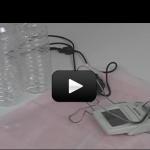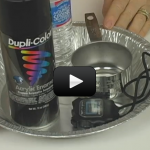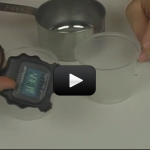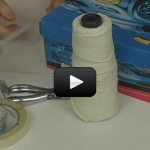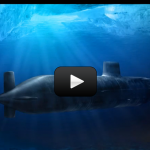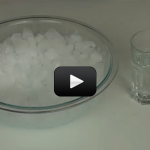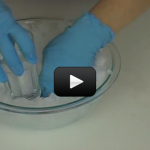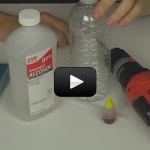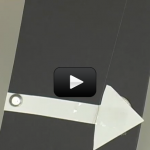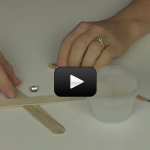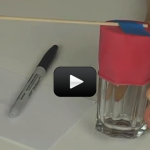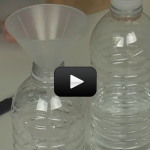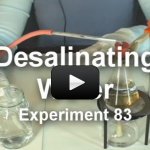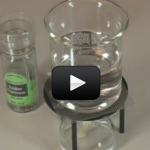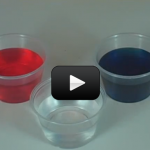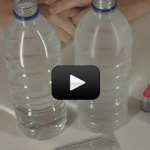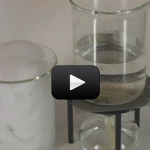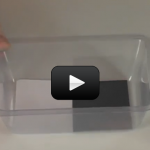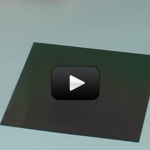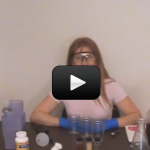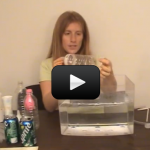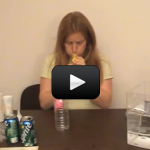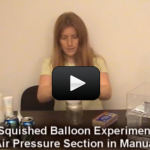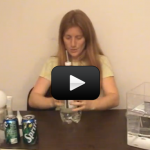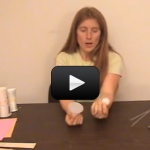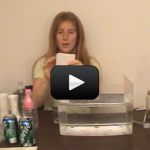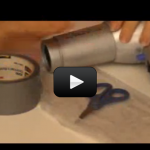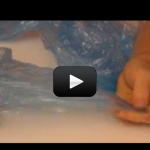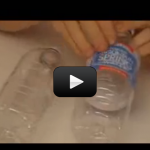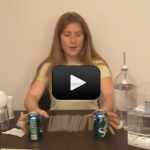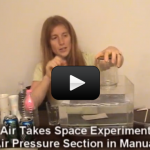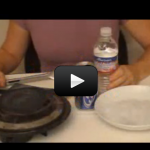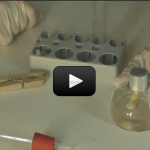Atmospheres
Scientists do experiments here on Earth to better understand the physics of distant worlds. We’re going to simulate the different atmospheres and take data based on the model we use. Each planet has its own unique atmospheric conditions. Mars and Mercury have very thin atmospheres, while Earth has a decent atmosphere (as least, we like to … Continue reading "Atmospheres" |
How Much Energy Does the Sun Produce?
Without the sun, there would be no life on Earth. The sun warms the earth, generates wind, and carries water into the air to produce rain and snow. The energy of the sun provides sunlight for all the plant life on our planet, and through plants provides energy for all animals. The sun is like … Continue reading "How Much Energy Does the Sun Produce?" |
How Can Water Be Used to Store Heat Energy?
Temperature is a measure of the average hotness of an object. The hotter an object, the higher its temperature. As the temperature is raised, the atoms and molecules in an object move faster. The molecules in hot water move faster than the molecules in cold water. Remember that the heat energy stored in an object … Continue reading "How Can Water Be Used to Store Heat Energy?" |
Can Wind Be Used as a Source of Energy?
The United States has large reserves of coal, natural gas, and crude oil which is used to make gasoline. However, the United States uses the energy of millions of barrels of crude oil every day, and it must import about half its crude oil from other countries. Burning fossil fuels (oil, coal, gasoline, and natural … Continue reading "Can Wind Be Used as a Source of Energy?" |
Cartesian Diver
Rene Descartes (1596-1650) was a French scientist and mathematician who used this same experiment show people about buoyancy. By squeezing the bottle, the test tube (diver) sinks and when released, the test tube surfaces. You can add hooks, rocks, and more to your set up to make this into a buoyancy game! |
Instant Ice
Supercooling a liquid is a really neat way of keeping the liquid a liquid below the freezing temperature. Normally, when you decrease the temperature of water below 32oF, it turns into ice. But if you do it gently and slowly enough, it will stay a liquid, albeit a really cold one! In nature, you’ll find … Continue reading "Instant Ice" |
Hot Ice Sculptures
Did you know that supercooled liquids need to heat up in order to freeze into a solid? It’s totally backwards, I know…but it’s true! Here’s the deal: A supercooled liquid is a liquid that you slowly and carefully bring down the temperature below the normal freezing point and still have it be a liquid. We … Continue reading "Hot Ice Sculptures" |
Cloud Tracker Weather Instrument
One of the most remarkable images of our planet has always been how dynamic the atmosphere is a photo of the Earth taken from space usually shows swirling masses of white wispy clouds, circling and moving constantly. So what are these graceful puffs that can both frustrate astronomers and excite photographers simultaneously? Clouds are frozen … Continue reading "Cloud Tracker Weather Instrument" |
Thermometer
First invented in the 1600s, thermometers measure temperature using a sensor (the bulb tip) and a scale. Temperature is a way of talking about, measuring, and comparing the thermal energy of objects. We use three different kinds of scales to measure temperature. Fahrenheit, Celsius, and Kelvin. (The fourth, Rankine, which is the absolute scale for … Continue reading "Thermometer" |
Hygrometer
Hygrometers measure how much water is in the air, called humidity. If it's raining, it's 100% humidity. Deserts and arid climates have low humidity and dry skin. Humidity is very hard to measure accurately, but scientists have figured out ways to measure how much moisture is absorbed by measuring the change in temperature (as with … Continue reading "Hygrometer" |
Anemometer
Most weather stations have anemometers to measure wind speed or wind pressure. The kind of anemometer we’re going to make is the same one invented back in 1846 that measures wind speed. Most anemometers use three cups, which is not only more accurate but also responds to wind gusts more quickly than a four-cup model. … Continue reading "Anemometer" |
Barometer
A barometer uses either a gas (like air) or a liquid (like water or mercury) to measure pressure of the atmosphere. Scientists use barometers a lot when they predict the weather, because it’s usually a very accurate way to predict quick changes in the weather. Barometers have been around for centuries – the first one … Continue reading "Barometer" |
Rain Gauge
Also known as an udometer or pluviometer or ombrometer, or just plan old ‘rain cup’, this device will let you know how much water came down from the skies. Folks in India used bowls to record rainfall and used to estimate how many crops they would grow and thus how much tax to collect! These … Continue reading "Rain Gauge" |
Desalination
This experiment is for advanced students. Lewis and Clark did this same experiment when they reached the Oregon coast in 1805. Men from the expedition traveled fifteen miles south of the fort they had built at the mouth of the Columbia River to where Seaside, Oregon now thrives. In 1805, however, it was just men … Continue reading "Desalination" |
Convection Currents
Every time I’m served a hot bowl of soup or a cup of coffee with cream I love to sit and watch the convection currents. You may look a little silly staring at your soup but give it a try sometime! Convection is a little more difficult to understand than conduction. Heat is transferred by … Continue reading "Convection Currents" |
Sensing Temperature
Temperature is a way of talking about, measuring, and comparing the thermal energy of objects. |
Food Dye Currents
When something feels hot to you, the molecules in that something are moving very fast. When something feels cool to you, the molecules in that object aren’t moving quite so fast. Believe it or not, your body perceives how fast molecules are moving by how hot or cold something feels. Your body has a variety … Continue reading "Food Dye Currents" |
Making Clouds
Indoor Rain Clouds Making indoor rain clouds demonstrates the idea of temperature, the measure of how hot or cold something is. Here’s how to do it: Take two clear glasses that fit snugly together when stacked. (Cylindrical glasses with straight sides work well.) Fill one glass half-full with ice water and the other half-full with … Continue reading "Making Clouds" |
Soaking Up Rays
Heat is transferred by radiation through electromagnetic waves. Remember, when we talked about waves and energy? Well, heat can be transferred by electromagnetic waves. Energy is vibrating particles that can move by waves over distances right? Well, if those vibrating particles hit something and cause those particles to vibrate (causing them to move faster/increasing their … Continue reading "Soaking Up Rays" |
Liquid Crystals
If you’ve completed the Soaking Up Rays experiment, you might still be a bit baffled as to why there’s a difference between black and white. Here’s a great way to actually “see” radiation by using liquid crystal thermal sheets. You’ll need to find a liquid crystal sheet that has a temperature range near body temperature … Continue reading "Liquid Crystals" |
Water Purification
Ever wonder how the water draining down your sink gets clean again? Think about it: The water you use to clean your dishes is the same water that runs through the toilet. There is only one water pipe to the house, and that source provides water for the dishwasher, tub, sink, washing machine, toilet, fish … Continue reading "Water Purification" |
Streaming Water
Fill the bathtub and climb in. Grab your water bottle and tack and poke several holes into the lower half the water bottle. Fill the bottle with water and cap it. Lift the bottle above the water level in the tub and untwist the cap. Water should come streaming out. Close the cap and the … Continue reading "Streaming Water" |
Sneaky Bottles
This experiment illustrates that air really does take up space! You can’t inflate the balloon inside the bottle without the holes, because it’s already full of air. When you blow into the bottle with the holes, air is allowed to leak out making room for the balloon to inflate. With the intact bottle, you run … Continue reading "Sneaky Bottles" |
Squished Balloon
Fire eats air, or in more scientific terms, the air gets used up by the flame and lowers the air pressure inside the jar. The surrounding air outside the jar is now at a higher pressure than the air inside the jar and it pushes the balloon into the jar. Remember: Higher pressure pushes! Materials: … Continue reading "Squished Balloon" |
Fountain Bottle
As you blow air into the bottle, the air pressure increases inside the bottle. This higher pressure pushes on the water, which gets forced up and out the straw (and up your nose!). Materials: small lump of clay, water, a straw, and one empty 2-liter soda bottle. |
Ping Pong Funnel
As you blow into the funnel, the air under the ball moves faster than the other air surrounding the ball, which generates an area of lower air pressure. The pressure under the ball is therefore lower than the surrounding air which is, by comparison, at a higher pressure. This higher pressure pushes the ball back … Continue reading "Ping Pong Funnel" |
Magic Water Glass Trick
Where’s the pressure difference in this trick? At the opening of the glass. The water inside the glass weighs a pound at best, and, depending on the size of the opening of the glass, the air pressure is exerting 15-30 pounds upward on the bottom of the card. Guess who wins? Tip, when you get … Continue reading "Magic Water Glass Trick" |
Hot Air Balloon
About 400 years ago, Leonardo da Vinci wanted to fly… so he studied the only flying things around at that time: birds and insects. Then he did what any normal kid would do—he drew pictures of flying machines! Centuries later, a toy company found his drawing for an ornithopter, a machine that flew by flapping … Continue reading "Hot Air Balloon" |
Diaper Wind Bag
Lots of science toy companies will sell you this experiment, but why not make your own? You’ll need to find a loooooong bag, which is why we recommend a diaper genie. A diaper genie is a 25′ long plastic bag, only both ends are open so it’s more like a tube. You can get three … Continue reading "Diaper Wind Bag" |
Genie in a Bottle
While this isn’t actually an air-pressure experiment but more of an activity in density, really, it’s still a great visual demonstration of why Hot Air Balloons rise on cold mornings. Imagine a glass of hot water and a glass of cold water sitting on a table, side by side. Now imagine you have a way … Continue reading "Genie in a Bottle" |
Soda Can Trick
When air moves, the air pressure decreases. This creates a lower air pressure pocket right between the cans relative to the surrounding air. Because higher pressure pushes, the cans clink together. Just remember – whenever there’s a difference in pressure, the higher pressure pushes. You will need about 25 straws and two empty soda cans … Continue reading "Soda Can Trick" |
Air Takes Space
You’re about to play with one of the first methods of underwater breathing developed for scuba divers hundreds of years ago.! Back then, scientists would invert a very large clear, bell-shaped jar over a diver standing on a platform, then lower the whole thing into the water. Everyone thought this was a great idea, until … Continue reading "Air Takes Space" |
Squished Soda Can
An average can of soda at room temperature measures 55 psi before you ever crack it open. (In comparison, most car tires run on 35 psi, so that gives you an idea how much pressure there is inside the can!) If you heat a can of soda, you’ll run the pressure over 80 psi before … Continue reading "Squished Soda Can" |
Can Fish Drown?
If you’ve ever owned a fish tank, you know that you need a filter with a pump. Other than cleaning out the fish poop, why else do you need a filter? (Hint: think about a glass of water next to your bed. Does it taste different the next day?) There are tiny air bubbles trapped … Continue reading "Can Fish Drown?" |

